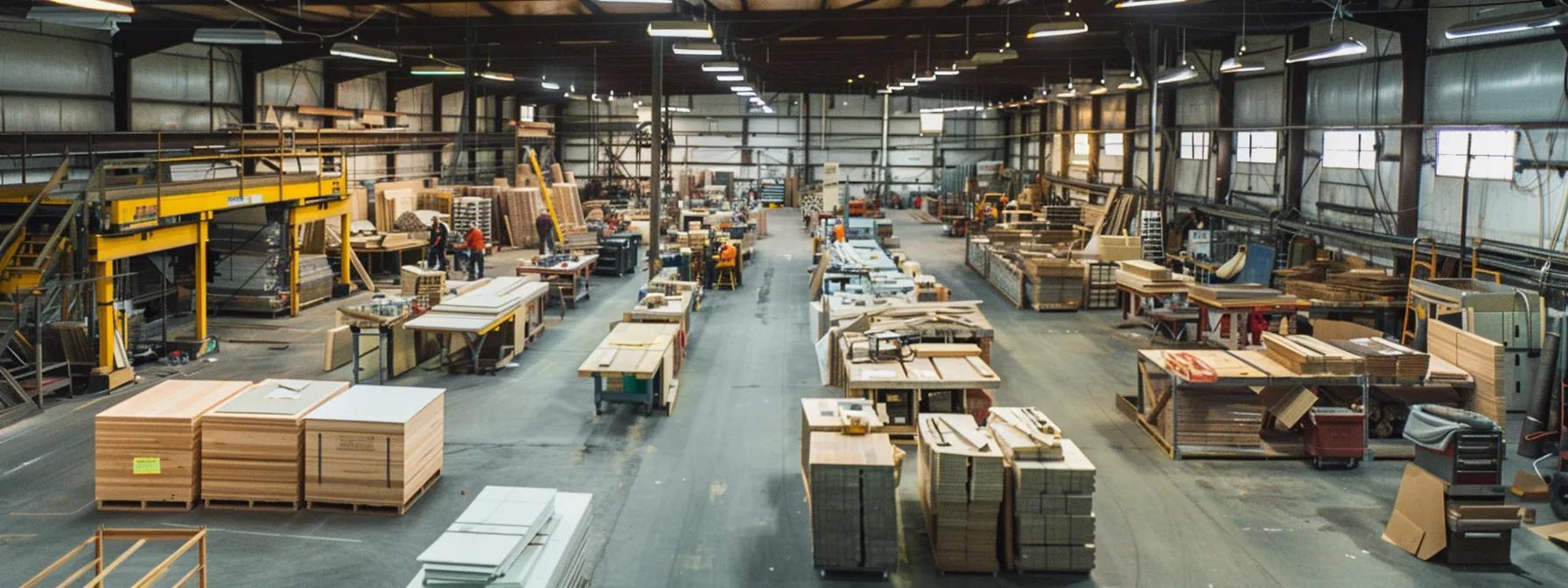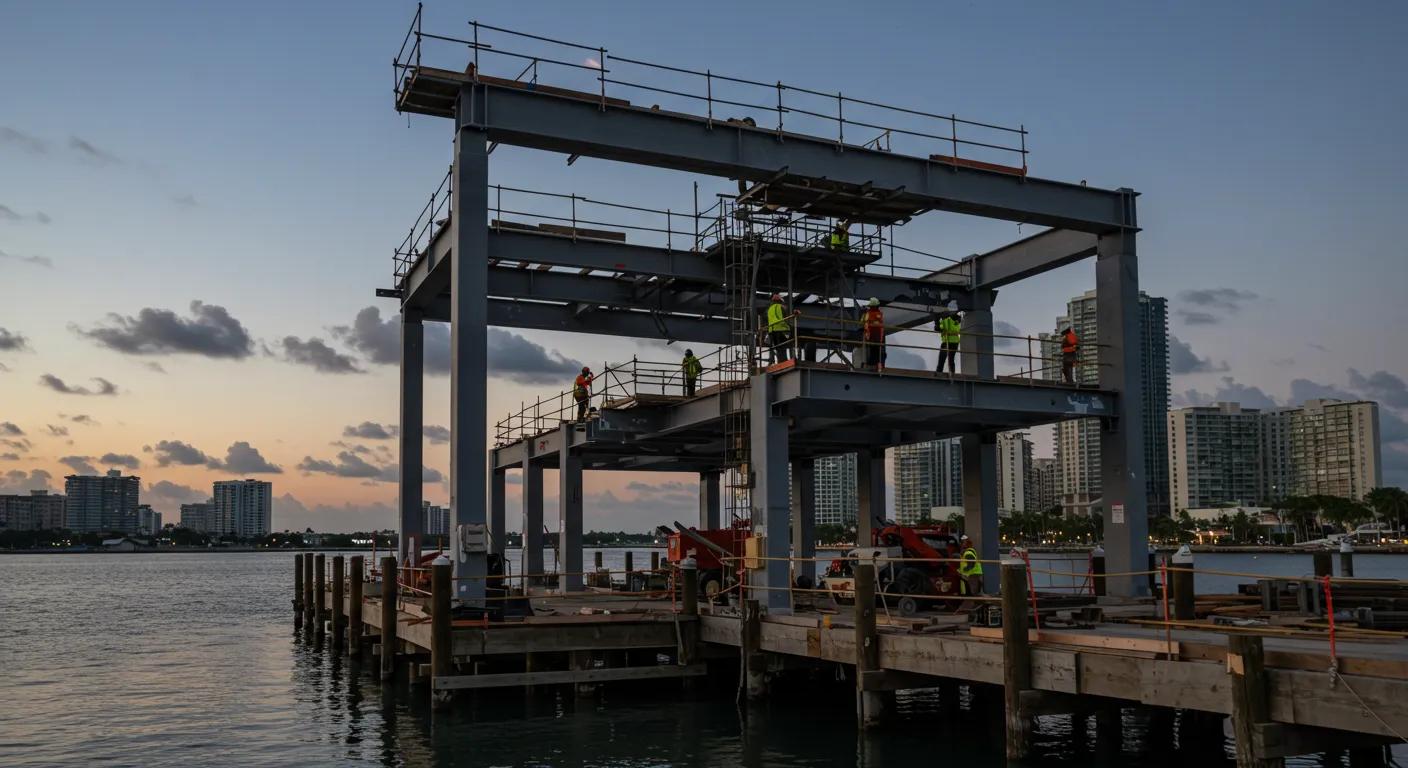Custom Dock Layout Strategies for Unique Needs
In planning a custom dock layout for your property, you face the challenge of merging aesthetics, functionality, and safety while maximizing your waterfront space. A well-designed dock enhances your property’s visual appeal, improves watercraft access, supports recreational activities, and maintains waterfront integrity. Whether you need a floating dock for a lake, a metal system for yacht docking, or environmentally friendly alternatives, American installers blend materials like polyethylene, wood, and corrosion-resistant metals with equipment such as boat lifts and safety bumpers to ensure durability, efficiency, and longevity. This article covers foundational considerations, recreational needs, watercraft adaptations, and accessibility—end-to-end solutions tailored to your property. Detailed guidance on material choices, structural elements, and planning future modifications is provided, all backed by technical insights and real-world scenarios.
Transitioning into our discussion, let’s explore the building blocks of your custom dock layout design.
Foundational Custom Dock Layout Considerations for Your Property
Begin by assessing your property’s water body, shoreline, and planned uses. Evaluate water depth, flow, and flood potential to choose the appropriate dock type. Check the shoreline’s topography to determine stability and material needs. In addition, review local regulations and permits to avoid complications. Establishing a clear budget early is crucial since costs vary based on materials, engineering, and additional features like lifts or integrated storage. Early financial planning helps guide design choices and scheduling.
Analyze water properties such as current strength, clarity, and seasonal fluctuations. Hydrological data inform whether a floating or fixed dock is best. Soil tests and topographical surveys guide the choice of anchoring methods and reinforcement needs. A well-thought-out strategy integrates the dock visually with the environment while ensuring long-term safety and durability.
Assessing Water Body Characteristics for Dock Design
Begin by understanding water quality, depth, current speed, and seasonal changes. For example, deep lakes with calm water might support permanent structures, while flowing rivers may require floating docks that adjust with water levels. Conduct hydrological surveys to gather data on temperature, clarity, and flood impacts. Assess seasonal patterns and potential hazards, such as underwater currents or debris, and consider using high-quality pump systems and safety features like well-placed ladders and railings. This thorough assessment ensures a dock design that is both efficient and safe.
Analyzing Shoreline Conditions and Topography
Conduct surveys to measure soil stability, slope gradients, and erosion risks. Shoreline conditions determine the foundation type; rocky or sandy beds may need different anchoring than clay soils. Use topographical maps to identify natural features that might support or hinder construction. Steep slopes might require retaining walls or scaffolding, while flat areas allow broader designs. Consider vegetation and wildlife habitats, as environmental permits may limit modifications. These surveys not only shape material choices but also help manage landslide or flood risks.
Determining Primary Uses for Your Custom Dock
Identify your main activities—swimming, fishing, water sports, or social gatherings—and design accordingly. For water sports, allocate an unobstructed, non-slip area; for leisure or entertaining, include built-in seating and shade structures. Safety features, such as ladders, railings, and ramps, are essential if elderly or disabled users are expected. The dock’s purpose influences material choices; high-traffic areas may require durable, low-maintenance materials. Consulting with designers through sketches and plans will optimize spatial requirements and ensure the dock meets both aesthetic and practical needs.
Reviewing Local Regulations and Permitting for Dock Construction
Consult local authorities and environmental agencies to gather guidelines before design begins. Regulations may dictate dimensions, construction methods, and permitted materials. Review zoning laws, building codes, and floodplain requirements to ensure compliance and to potentially gain recommendations for additional safety features. Working with a certified installer familiar with local permits can streamline this process and help avoid delays and legal issues.
Establishing a Budget for Your Custom Dock Project
Define your project scope and list materials, labor, and permit fees to develop a comprehensive budget. Consider both construction costs and long-term maintenance expenses. Allocate funds for quality materials like corrosion-resistant metals, polyethylene decking, or reclaimed wood, based on design needs. Obtain detailed estimates from experienced dock builders, and include contingency funds for unforeseen issues such as additional reinforcement or water damage. A clear, realistic budget guides design decisions and ensures the project remains feasible and sustainable.
Designing Dock Layouts for Specific Recreational Pursuits
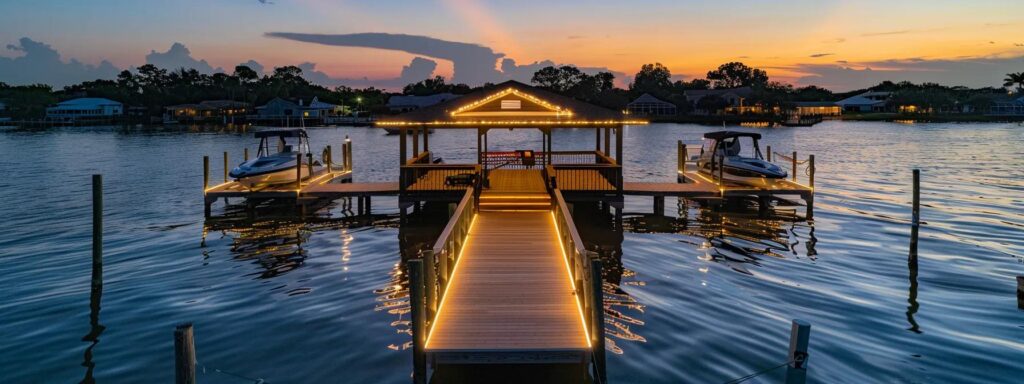
Tailor your dock layout to support the recreational activities you enjoy. Whether for swimming, boating, or socializing, the design must facilitate safety and accessibility while enhancing user experience.
Crafting a Custom Dock Layout for Swimming and Sunbathing
Design a spacious, open area that permits easy water access and provides a dedicated sunbathing zone with weather-resistant surfaces. Leave ample space between the dock end and the waterline so swimmers can enter safely, away from boat traffic. Use non-slip decking—such as treated wood or composite decking—and consider anti-fatigue mats for prolonged sunbathing. Incorporate shade structures like retractable awnings or canopies, and ensure clearly marked entry points with gradual slopes for added safety. Also, plan for proper drainage to maintain the dock’s appearance and longevity.
Arranging Dock Space for Fishing and Watersports
Create distinct zones for different activities. Design quiet corners with built-in rod holders and seating for fishing, while allocating open spaces for active watersports like kayaking, canoeing, and jet-skiing. Safety features like lip guards and clear walkways reduce risks during transitions. Consider modular sections that can be reconfigured seasonally and include weather-resistant storage for gear such as life jackets and fishing equipment. This versatile planning enhances usability and enjoyment across multiple recreational activities.
Planning a Dock Configuration for Entertaining and Social Gatherings
Design a dock that serves as a social hub by including open spaces and comfortable seating arrangements. Integrate built-in benches, tables, and even outdoor cooking facilities. Ensure a smooth flow from the dock to the water so guests can easily move between activities. Ambient deck lighting enhances the social atmosphere in the evening, while accessible pathways and non-slip surfaces contribute to overall safety. Thoughtful seating curves and designated dining zones help create a welcoming environment for gatherings.
Integrating Storage Solutions Within Your Dock Design
Plan for integrated storage by allocating areas built into the dock structure to securely house watercraft accessories, safety equipment, and recreational gear. Consider built-in cabinets, under-deck compartments, and waterproof storage boxes that maintain the dock’s aesthetics. Depending on usage—whether for boating or leisure—design storage for ropes, fenders, life jackets, chairs, and barbecue tools. Use durable, water-resistant materials like polyethylene and marine-grade plywood to ensure longevity and reduce clutter.
Optimizing Your Custom Dock Layout for Wildlife Observation
Design quiet, undisturbed zones for wildlife observation by incorporating elevated observation decks and discreet seating. Minimize artificial lighting during dawn or dusk to attract local wildlife, and use eco-friendly materials that blend with the natural environment. Optional surveillance features like discreet cameras or bird-watching scopes can enhance the observation experience without disturbing nature. This approach promotes both enjoyment of local wildlife and a balanced ecosystem around your dock.
This section further explores tailoring dock layouts to diverse recreational activities for maximum flexibility and user engagement.
Custom Dock Layout Strategies for Multiple Small Boats
For accommodating multiple small boats, allocate separate mooring spaces with ample clearances. Design the layout with evenly spaced cleats and include boat lifts or hoists if needed. Establish distinct zones to prevent overlapping and reduce collision risk. Integrate storage for maintenance tools and spare parts to keep the deck organized. With clear pathways and strategically placed moorings, your dock becomes an efficient, harmonious system for various watercraft.
Designing a Dock to Accommodate Larger Vessels
When designing for larger vessels, ensure the dock can handle greater loads by incorporating reinforced support structures and heavy-duty boat lifts. Provide wider channels for maneuvering and deeper water access for improved vessel stability. Consider using composite materials or high-density polyethylene for durability and resistance to water damage. Integrate multiple anchoring systems to distribute weight evenly and maintain stability during adverse weather conditions.
Incorporating Lifts and Hoists Into Your Dock Plan
Identify key locations where lifts or hoists will ease the transfer of watercraft. A strategically placed lift can simplify boarding and launching while reducing manual handling and injury risk. Whether choosing hydraulic, mechanical, or electronic systems, ensure compatibility with dock materials and adherence to local safety standards. Position these systems near storage or repair areas to create a multifunctional space that enhances operational efficiency.
Ensuring Safe Mooring With Strategic Cleat Placement
Plan safe mooring by installing cleats in a logical grid pattern that provides easy access and quick adjustments for high-tide or storm conditions. Use corrosion-resistant metal or durable composite cleats and incorporate adjustable lines to secure vessels firmly. Clearly defined mooring points minimize the risk of collisions when multiple boats dock simultaneously, ensuring overall safety for both watercraft and dock structure.
Custom Dock Layout Considerations for Easy Boat Access and Launching
Ensure clear and unobstructed pathways from the dock to the water by designing uncluttered launching zones with integrated lift systems. Include gently sloping ramps, accessible gangways, and well-placed ladders or stairs for boarding. Safety railings and non-slip surfaces further enhance accessibility, while emergency exit routes and backup boat lifts help in swift departures. This clarity in design enhances both functionality and user safety.
Implementing Accessibility Features in Your Custom Dock Layout
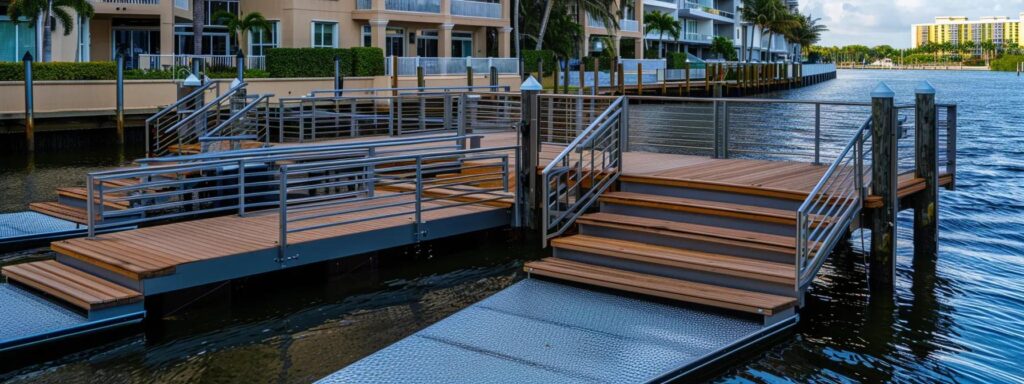
Accessibility is key to ensuring that everyone—from children to seniors and individuals with disabilities—can use the dock safely. Integrate ramps, gangways, and carefully selected materials to create a smooth transition between the dock and the water.
Building Ramps and Gangways for Smooth Transitions
Design ramps with gentle inclines that comply with regulatory standards to support wheelchair users and those with mobility challenges. Wide gangways made from non-slip materials, such as textured composites or treated wood, along with handrails on both sides, ensure balanced and safe transit. Regular maintenance guarantees that these structures remain secure and effective over time.
Selecting Appropriate Surface Materials for Safety and Access
Choose durable, slip-resistant surface materials like composite decking, treated wood, or high-quality polyethylene. Ensure these materials meet ASTM and other safety standards while resisting UV exposure and saltwater corrosion. Marine-grade composites not only offer safety but also contribute to a clean, modern aesthetic on the dock surface.
Designing Railings and Handholds for Support
Install continuous railings along active edges with evenly spaced handholds crafted from corrosion-resistant materials such as stainless steel or treated wood. These features provide necessary support and enhance the overall aesthetic while minimizing fall risks.
Creating Adequate Space for Maneuverability
Plan for wide, unobstructed pathways that allow free movement for people and supplies. Sufficient turning radii and clear spaces near launch areas reduce accident risks and facilitate smooth navigation, which is especially important during emergencies.
Considering Accessible Fishing and Seating Areas in the Dock Layout
Design designated zones with comfortable seating and lowered rod holders to ensure that fishing and relaxational seating areas are easily accessible. Ensure these spaces connect smoothly with main pathways, using non-slip materials to provide a secure and inviting environment for all users.
Material Choices and Structural Elements in Custom Dock Layout Strategies
Selecting the right materials and structural elements is essential for a dock that is durable, safe, and visually pleasing. Balance factors such as maintenance, environmental resistance, lifespan, and cost when making your decision.
Comparing Durability and Maintenance of Dock Materials
Evaluate key attributes like resistance to water damage, UV degradation, and corrosion. For instance, treated wood offers a classic look but needs regular upkeep, while composite decking and high-density polyethylene are more durable with low maintenance. The table below summarizes common dock materials:
| Material | Durability Rating | Maintenance Frequency | Lifespan (Years) | Key Benefit |
|---|---|---|---|---|
| Treated Wood | Medium | Annual | 15-20 | Traditional aesthetic |
| Composite Decking | High | Low | 25-30 | Low maintenance, weatherproof |
| Marine-Grade Steel | Very High | Bi-annual | 30-35 | Exceptional strength and longevity |
| High-Density Polyethylene | High | Low | 20-25 | Resistant to chemical corrosion |
| Reclaimed Wood | Medium | Annual | 15-20 | Eco-friendly, unique texture |
Discuss your options with engineers or experienced installers to ensure that chosen materials best match your design needs and local conditions.
Custom Dock Layout Considerations for Floating Versus Fixed Structures
Decide between floating and fixed docks by considering water body behavior and functional needs. Fixed docks offer stability in areas with minor water level changes, while floating docks adjust with significant seasonal fluctuations. Each system requires its own engineering approach and anchoring methods.
Ensuring Stability and Load-Bearing Capacity
Reinforce stability by using engineered supports, concrete footings, and additional bracing. Validate the design with load tests or simulations to ensure every section supports watercraft weight and dynamic weather loads, guaranteeing long-term safety and functionality.
Selecting Anchoring Methods Suited to Your Unique Needs
Choose anchoring methods based on environmental conditions and expected loads. Options include driven piles for rocky or clay-rich soils and screw anchors for softer, sandy substrates. Compliance with local construction permits and regulations is essential for safety and longevity.
Incorporating Protective Bumpers and Fenders in the Layout
Integrate protective features such as bumpers and fenders along the dock’s perimeter to cushion impacts during docking. Use materials like rubber or engineered polymers that absorb shocks and resist UV damage. Regular maintenance of these elements helps protect both the dock and your watercraft.
Planning for Future Adaptability in Your Custom Dock Layout
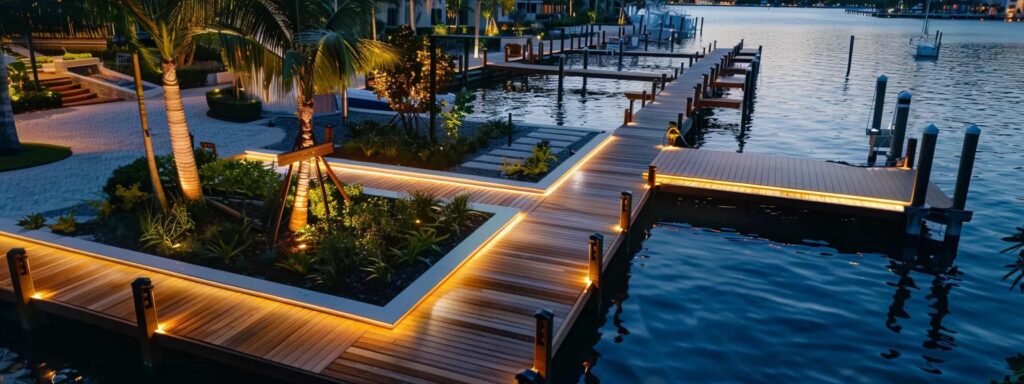
Design your dock with adaptability in mind to accommodate future changes in usage patterns, property conditions, and technology.
Designing Modular Sections for Future Expansion or Reconfiguration
Construct your dock with interchangeable, modular components. Standardized connectors and detachable panels allow you to add, remove, or rearrange sections easily as needs change, facilitating future expansions or repairs without major reconstruction.
Anticipating Changes in Water Levels or Use Patterns
Use historical data and environmental analysis to anticipate water level changes and user trends. Incorporate floating components, adjustable sections, or built-in sensors to adapt to seasonal variations and shifting recreational demands.
Selecting Materials That Allow for Modifications
Opt for high-performance, adaptable materials such as composite or high-density plastics that can be modified or extended as needed. These materials facilitate future enhancements with minimal disruption and cost.
Integrating Utility Access for Future Additions
Include pre-planned conduits and service channels for electrical, water, and smart technology installations. This foresight allows you to add security, lighting, or other technological upgrades without extensive rework.
Long-Term Custom Dock Layout Considerations for Evolving Needs
Maintain a flexible design by using modular sections, adaptable materials, and expandable utility networks. Regular consultations with design professionals help ensure your dock evolves with technological advances and changing lifestyle needs while preserving its structural integrity.
Final Thoughts
Your custom dock layout must blend functionality with aesthetics to meet evolving recreational and operational demands. By carefully assessing your water body, shoreline, and intended uses—and incorporating adaptive design features—you can create a resilient, versatile waterfront installation. Future-proofing through modular design, adaptable materials, and integrated utility access ensures your dock remains a valuable asset over time. Embrace both safety and innovation to support long-term benefits for your lifestyle and property value.
Frequently Asked Questions
Q: How do I begin planning a custom dock layout for my property? A: Start by assessing your water body’s characteristics, evaluating shoreline conditions, and defining primary uses. This helps determine the best materials and design features for safety, durability, and functionality.
Q: What factors should I consider when choosing dock materials? A: Consider durability, maintenance needs, environmental resistance, and aesthetic appeal. Options like treated wood, composite decking, marine-grade steel, and high-density polyethylene each offer distinct benefits.
Q: How can I ensure my dock remains accessible for all users? A: Integrate ramps, gangways, railings, and non-slip surfaces to promote smooth transitions and safe mobility, ensuring accessibility for users with disabilities and the elderly.
Q: What’s the benefit of designing a modular dock layout? A: A modular design allows for easy future expansion or reconfiguration as usage patterns change, enabling you to adapt utility access and incorporate new safety features without a complete overhaul.
Q: How do I address fluctuations in water levels with my dock design? A: Incorporate floating elements, adjustable sections, and robust anchoring systems. Detailed hydrological analysis and adaptable materials ensure your dock remains secure and functional through seasonal variations.

